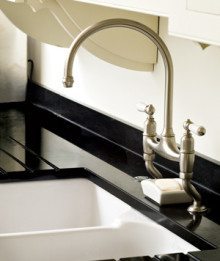In our previous Buyer Beware post, we discussed what to keep in mind when inspecting a renovated property. When deciding to buy, home buyers often takes into account the condition of the big structural elements, but sometimes it’s the little things that can turn a bargain into a money pit – even simple items like taps and sinks. Tap into that sinking feeling before you make an offer so you’re not in for an unexpected plumbing overhaul that blows the budget.
In general, check for wear and tear and age, which may indicate whether these pieces of equipment are due for a refit or replacement.
Go with the flow
 Test taps to check turning corresponds to water capacity
Test taps to check turning corresponds to water capacityYou’re going to use taps and sinks every day so during an inspection, turn on all the taps to their full capacity and watch for drainage problems in the sinks. This is what to look for:
-
Age of the taps:
After six years old, the internals will be wearing down. Many taps start to leak at this point and replacing rather than repair is the best option. If the surface is pitted or the chrome is wearing, this indicates an aged tap.
-
Proper operation and tightness of tap handles:
Can you turn the tap on and off easily? Are there any visible leaks when you operate the tap? Does the water pressure correspond to the turning?
-
Water pressure:
Pressure over 500kpa (kilopascals) damages pipes, taps, dishwashers, and hot water units and causes water hammer. A pressure regulating valve can be installed to save high value fixtures and ease water hammer.
-
Aerators should be clean:
These are found in the opening where the water comes out. Dirty aerators will affect water quality and may indicate a problem with the delivery pipes.
-
Condition of flexible pipes under the sink:
If they leak or look worn, they will need replacement soon.
-
Leaks from mini isolation valves:
This indicates that the valves are not working properly and they may need replacement.
-
Condition of the water filter:
Check its use-by date and whether it needs replacement.
-
Ease of drainage:
Assess how freely each sink/basin drains. Slow to drain? This may indicate blocked pipes and drains. Attend to any leaks.
We also recommend that a building inspection take place before purchasing any property, be it new, renovated or old. You should also request a copy of the property’s drainage diagram, which identifies the position of all the fixtures and fittings. This diagram is very important as it provides all the information about the foundation of the house. If it is not up-to-date, it may indicate that unauthorised renovations have taken place, so beware!
Doing an inspection will give you an idea of the right price for the property and will also help you put together a post-purchase budget in case you need to spend money on renovation.

